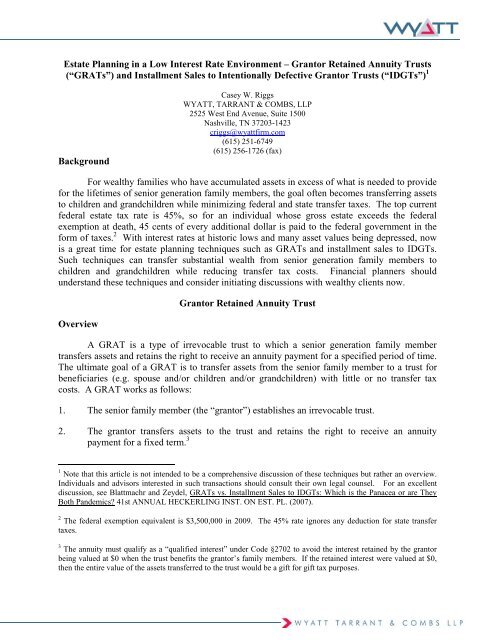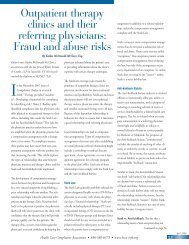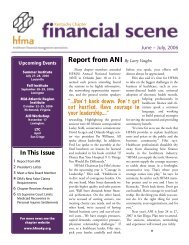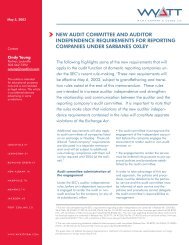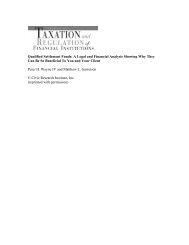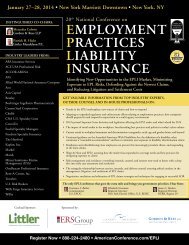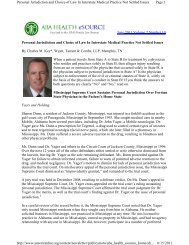Estate Planning in a Low Interest Rate Environment – Grantor ...
Estate Planning in a Low Interest Rate Environment – Grantor ...
Estate Planning in a Low Interest Rate Environment – Grantor ...
You also want an ePaper? Increase the reach of your titles
YUMPU automatically turns print PDFs into web optimized ePapers that Google loves.
<strong>Estate</strong> <strong>Plann<strong>in</strong>g</strong> <strong>in</strong> a <strong>Low</strong> <strong>Interest</strong> <strong>Rate</strong> <strong>Environment</strong> <strong>–</strong> <strong>Grantor</strong> Reta<strong>in</strong>ed Annuity Trusts<br />
(“GRATs”) and Installment Sales to Intentionally Defective <strong>Grantor</strong> Trusts (“IDGTs”) 1<br />
Background<br />
Casey W. Riggs<br />
WYATT, TARRANT & COMBS, LLP<br />
2525 West End Avenue, Suite 1500<br />
Nashville, TN 37203-1423<br />
criggs@wyattfirm.com<br />
(615) 251-6749<br />
(615) 256-1726 (fax)<br />
For wealthy families who have accumulated assets <strong>in</strong> excess of what is needed to provide<br />
for the lifetimes of senior generation family members, the goal often becomes transferr<strong>in</strong>g assets<br />
to children and grandchildren while m<strong>in</strong>imiz<strong>in</strong>g federal and state transfer taxes. The top current<br />
federal estate tax rate is 45%, so for an <strong>in</strong>dividual whose gross estate exceeds the federal<br />
exemption at death, 45 cents of every additional dollar is paid to the federal government <strong>in</strong> the<br />
form of taxes. 2 With <strong>in</strong>terest rates at historic lows and many asset values be<strong>in</strong>g depressed, now<br />
is a great time for estate plann<strong>in</strong>g techniques such as GRATs and <strong>in</strong>stallment sales to IDGTs.<br />
Such techniques can transfer substantial wealth from senior generation family members to<br />
children and grandchildren while reduc<strong>in</strong>g transfer tax costs. F<strong>in</strong>ancial planners should<br />
understand these techniques and consider <strong>in</strong>itiat<strong>in</strong>g discussions with wealthy clients now.<br />
Overview<br />
<strong>Grantor</strong> Reta<strong>in</strong>ed Annuity Trust<br />
A GRAT is a type of irrevocable trust to which a senior generation family member<br />
transfers assets and reta<strong>in</strong>s the right to receive an annuity payment for a specified period of time.<br />
The ultimate goal of a GRAT is to transfer assets from the senior family member to a trust for<br />
beneficiaries (e.g. spouse and/or children and/or grandchildren) with little or no transfer tax<br />
costs. A GRAT works as follows:<br />
1. The senior family member (the “grantor”) establishes an irrevocable trust.<br />
2. The grantor transfers assets to the trust and reta<strong>in</strong>s the right to receive an annuity<br />
payment for a fixed term. 3<br />
1 Note that this article is not <strong>in</strong>tended to be a comprehensive discussion of these techniques but rather an overview.<br />
Individuals and advisors <strong>in</strong>terested <strong>in</strong> such transactions should consult their own legal counsel. For an excellent<br />
discussion, see Blattmachr and Zeydel, GRATs vs. Installment Sales to IDGTs: Which is the Panacea or are They<br />
Both Pandemics? 41st ANNUAL HECKERLING INST. ON EST. PL. (2007).<br />
2 The federal exemption equivalent is $3,500,000 <strong>in</strong> 2009. The 45% rate ignores any deduction for state transfer<br />
taxes.<br />
3 The annuity must qualify as a “qualified <strong>in</strong>terest” under Code §2702 to avoid the <strong>in</strong>terest reta<strong>in</strong>ed by the grantor<br />
be<strong>in</strong>g valued at $0 when the trust benefits the grantor’s family members. If the reta<strong>in</strong>ed <strong>in</strong>terest were valued at $0,<br />
then the entire value of the assets transferred to the trust would be a gift for gift tax purposes.
3. The value of the assets transferred, less the present value of the annuity payments<br />
reta<strong>in</strong>ed by the grantor, is a gift to the trust for gift tax purposes. In most circumstances,<br />
the annuity payments back to the grantor are “solved for” such that the gift is equal or<br />
close to $0.<br />
4. The IRS assumes that the assets <strong>in</strong> the GRAT produce a total return equal to a prescribed<br />
<strong>in</strong>terest rate under Code 4 §7520. For July 2009, the §7520 rate is 3.40%.<br />
5. The trust assets (or cash flows generated from the trust assets) are used to make the<br />
annuity payments after the trust is funded. If the trust assets produce a total return over<br />
the term <strong>in</strong> excess of the §7520 rate, then there may be assets rema<strong>in</strong><strong>in</strong>g <strong>in</strong> the trust after<br />
the last annuity payment is made. If so, then the rema<strong>in</strong><strong>in</strong>g assets are available for the<br />
grantor’s beneficiaries and are not subject to federal estate taxes or state <strong>in</strong>heritance taxes<br />
at the grantor’s death.<br />
The key to mak<strong>in</strong>g a GRAT “successful” (i.e. hav<strong>in</strong>g assets left <strong>in</strong> the trust after the term<br />
ends and after all annuity payments have been made) is to transfer assets that produce a total<br />
return <strong>in</strong> excess of the <strong>in</strong>terest rate assumption required by the IRS at the time the GRAT is<br />
funded (i.e., the §7520 rate or 3.40% for July 2009).<br />
Example 1 - GRAT<br />
Assume $1,000,000 <strong>in</strong> marketable securities is transferred to a n<strong>in</strong>e (9) year GRAT <strong>in</strong><br />
July 2009 when the §7520 rate is 3.40%. The GRAT is “zeroed out,” mean<strong>in</strong>g that the value of<br />
the assets transferred is equal to the present value of the annuity payments to be received by the<br />
grantor based on the §7520 rate, result<strong>in</strong>g <strong>in</strong> a gift to the trust of $0.<br />
The yearly annuity payment required to zero out the GRAT <strong>in</strong> this circumstance is<br />
$130,840 5 . The trust cash flows and assets are shown below, assum<strong>in</strong>g an eight percent (8%)<br />
total return each year.<br />
4 References to the “Code” are to the Internal Revenue Code of 1986, as amended.<br />
5 This amount is solved for. The present value of these annuity payments at 3.40% equals $1,000,000 (assumes end<br />
of year payments).
End Yr.<br />
Beg. Yr. 8% Annuity End Yr.<br />
Trust Growth & Payment Trust<br />
Year Balance Income to <strong>Grantor</strong> Balance<br />
1 1,000,000 80,000 (130,840) 949,160<br />
2 949,160 75,933 (130,840) 894,253<br />
3 894,253 71,540 (130,840) 834,953<br />
4 834,953 66,796 (130,840) 770,909<br />
5 770,909 61,673 (130,840) 701,742<br />
6 701,742 56,139 (130,840) 627,041<br />
7 627,041 50,163 (130,840) 546,365<br />
8 546,365 43,709 (130,840) 459,234<br />
9 459,234 36,739 (130,840) 365,133<br />
In this example, at the end of n<strong>in</strong>e (9) years, the GRAT will have resulted <strong>in</strong> the transfer<br />
of assets hav<strong>in</strong>g a value of $365,133 from the grantor to the beneficiaries of the GRAT. These<br />
assets are not subject to estate or <strong>in</strong>heritance taxes <strong>in</strong> the grantor’s estate, so the GRAT strategy<br />
will have resulted <strong>in</strong> a tax-free transfer to the beneficiaries of this amount.<br />
Keys to Structur<strong>in</strong>g a GRAT<br />
1. Selection of Assets. Assets that generate significant cash flow relative to their fair<br />
market values or assets that are expected to appreciate significantly <strong>in</strong> value over a<br />
relatively short period of time should be used. While marketable securities may work,<br />
other assets such as closely held bus<strong>in</strong>ess <strong>in</strong>terests or rental real estate have the potential<br />
to perform even better. Closely held bus<strong>in</strong>ess <strong>in</strong>terests often receive discounts for lack of<br />
marketability and control for transfer tax purposes, which may <strong>in</strong>crease their<br />
effectiveness when used with a GRAT. Stock <strong>in</strong> a closely held bus<strong>in</strong>ess that may have an<br />
<strong>in</strong>itial public offer<strong>in</strong>g <strong>in</strong> the not too distant future may be an especially good choice.<br />
2. Volatility of Returns. Volatility of asset returns and cash flows must also be considered.<br />
In the simplified example above, the GRAT successfully transfers assets to the GRAT<br />
beneficiaries based on an 8% annual return. However, a GRAT that produces an average<br />
return of 8% over the term, but has negative returns <strong>in</strong> early years may not be successful.<br />
Negative returns comb<strong>in</strong>ed with the annuity payments may deplete the trust such that<br />
there are no assets rema<strong>in</strong><strong>in</strong>g after the annuity term, even when the trust earns the<br />
assumed rate over the entire term. Model<strong>in</strong>g the expected cash flows based on realistic<br />
assumptions is an important part of GRAT plann<strong>in</strong>g.<br />
3. GRAT Term. The term must be carefully considered when sett<strong>in</strong>g up a GRAT. If the<br />
grantor dies before all annuity payments are made, most or all of the property <strong>in</strong> the trust<br />
is <strong>in</strong>cluded <strong>in</strong> the grantor’s estate for federal estate tax purposes. Thus, the trust term<br />
needs to be short enough that the grantor is likely to survive the term. If the usual goal of<br />
“zero<strong>in</strong>g out” the GRAT is important, however, then a shorter term results <strong>in</strong> higher<br />
required annuity payments, which means the trust assets need to generate more cash flow.<br />
Balanc<strong>in</strong>g longevity risk with the usual goal of “zero<strong>in</strong>g out” the GRAT by extend<strong>in</strong>g the<br />
term is one of the greatest challenges <strong>in</strong> GRAT plann<strong>in</strong>g.
4. <strong>Grantor</strong> Trust Status. For <strong>in</strong>come tax purposes, the GRAT is a “grantor trust,” mean<strong>in</strong>g<br />
that trust <strong>in</strong>come is taxed to the grantor rather than the trust. This is an added benefit<br />
from an estate tax perspective, because the grantor’s payment of <strong>in</strong>come taxes on assets<br />
that benefit family members is essentially a tax-free gift to the family members. The<br />
payment of taxes by the grantor rather than the trust can have a substantial positive<br />
impact over time.<br />
5. Selection of Trustee. As with any trust, selection of the trustee is important. The grantor<br />
may serve as trustee dur<strong>in</strong>g the annuity term, but it is very important that the trustee<br />
selected comply with the GRAT provisions and requirements, such as mak<strong>in</strong>g annuity<br />
payments on time. The grantor cannot be trustee after the annuity term, so careful<br />
thought should be given to the selection of a successor trustee.<br />
Downsides<br />
What happens if the GRAT is not successful? If the GRAT assets do not generate<br />
sufficient total return to leave assets rema<strong>in</strong><strong>in</strong>g <strong>in</strong> the trust at the end of the annuity term, then the<br />
GRAT “fails,” mean<strong>in</strong>g that all assets <strong>in</strong> the GRAT are returned to the grantor and no assets have<br />
passed to the grantor’s beneficiaries. However, with the exception of the costs <strong>in</strong>curred <strong>in</strong><br />
sett<strong>in</strong>g up and adm<strong>in</strong>ister<strong>in</strong>g the GRAT, which are m<strong>in</strong>imal compared to the potential sav<strong>in</strong>gs,<br />
there is no downside. Because of this, it is often most beneficial to use short-term or “roll<strong>in</strong>g”<br />
GRATs (at least two years) and “try aga<strong>in</strong>” if the GRAT is not successful at the end of the term.<br />
This may be particularly true for speculative or volatile assets, such as pre-IPO stock.<br />
Because assets <strong>in</strong> the trust are not <strong>in</strong>cluded <strong>in</strong> the grantor’s estate if he survives the trust<br />
term, there is no step-up <strong>in</strong> the basis of the trust assets upon the grantor’s death. This reduces the<br />
sav<strong>in</strong>gs from a GRAT, but with the substantial disparity <strong>in</strong> estate tax rates (45%) versus longterm<br />
capital ga<strong>in</strong>s rate of (15%), the partial offset does not elim<strong>in</strong>ate the advantages of GRAT<br />
plann<strong>in</strong>g.<br />
Installment Sales To An Intentionally Defective <strong>Grantor</strong> Trust<br />
An alternative to a GRAT is an <strong>in</strong>stallment sale to an IDGT. This technique works as<br />
follows:<br />
1. The grantor establishes an irrevocable trust.<br />
2. The trust <strong>in</strong>cludes provisions caus<strong>in</strong>g it to be treated as a “grantor trust” for <strong>in</strong>come tax<br />
purposes, mean<strong>in</strong>g that all trust <strong>in</strong>come is taxed to the grantor. 6 Such a trust is often<br />
referred to as be<strong>in</strong>g “<strong>in</strong>tentionally defective”.<br />
3. The grantor “seeds” the trust with a small gift (usually at least ten percent (10%) of the<br />
value of the property <strong>in</strong> the trust after the sale).<br />
6 There are several ways to make a trust a grantor trust for <strong>in</strong>come tax purposes, however, this discussion is outside<br />
the scope of this article. See Code §671 et seq.
4. The grantor sells property to the trust <strong>in</strong> exchange for a promissory note.<br />
5. The IRS assumes that the trust assets earn a rate equal to the applicable federal rate<br />
(“AFR”) under Code §7872 based on the term of the note. The AFR rates for July 2009<br />
are as follows:<br />
Note Term 7872 <strong>Rate</strong> 7<br />
3 years or less 0.82%<br />
> 3 years to 9 years 2.76%<br />
> 9 years 4.36%<br />
6. The trust assets (or cash flows generated from the trust assets) are used to make the note<br />
payments after the trust is funded. If the trust assets produce a total return <strong>in</strong> excess of<br />
the AFR over the note term, then there may be assets rema<strong>in</strong><strong>in</strong>g <strong>in</strong> the trust when the note<br />
is fully paid off. If so, then the rema<strong>in</strong><strong>in</strong>g assets are available for the grantor’s<br />
beneficiaries and are not subject to federal estate taxes or state <strong>in</strong>heritance taxes at the<br />
grantor’s death.<br />
As with the GRAT, the key to mak<strong>in</strong>g an <strong>in</strong>stallment sale to an IDGT “successful”<br />
(aga<strong>in</strong>, this means hav<strong>in</strong>g assets left <strong>in</strong> the trust after the term ends and after the note has been<br />
paid off) is to transfer assets that produce a total return substantially <strong>in</strong> excess of the prescribed<br />
<strong>in</strong>terest rate. With an <strong>in</strong>stallment sale, however, the rate generally used is the AFR <strong>in</strong>stead of the<br />
§7520 rate, which is lower than §7520 rate for short-term and mid-term notes. Therefore, the<br />
<strong>in</strong>stallment sale has the potential to produce a better result than the GRAT if a short-term or midterm<br />
note is used, because the lower <strong>in</strong>terest rate results <strong>in</strong> a lower required payment back to the<br />
grantor, which, <strong>in</strong> turn, results <strong>in</strong> more assets rema<strong>in</strong><strong>in</strong>g <strong>in</strong> the trust after the note is paid off.<br />
Keys to Structur<strong>in</strong>g an Installment Sale to an IDGT<br />
All of the factors discussed above with respect to GRATs are also important with<br />
<strong>in</strong>stallment sales. However, there are some differences and additional considerations.<br />
1. Note Term. One difference between the GRAT and the <strong>in</strong>stallment sale is that the trust<br />
assets should not be <strong>in</strong>cluded <strong>in</strong> the grantor’s estate if the grantor dies dur<strong>in</strong>g the term. 8<br />
Instead, the rema<strong>in</strong><strong>in</strong>g obligations on the note would be <strong>in</strong>cluded. 9 However,<br />
consideration of the term is important from a cash flow standpo<strong>in</strong>t (i.e., will the trust<br />
assets generate sufficient cash flow to make the note payments?) and because the<br />
7 Assumes annual compound<strong>in</strong>g.<br />
8<br />
With an <strong>in</strong>stallment sale, there is some risk that the IRS might try to reclassify the <strong>in</strong>terest <strong>in</strong> the note as a reta<strong>in</strong>ed<br />
<strong>in</strong>terest <strong>in</strong> the trust assets, which would cause estate tax <strong>in</strong>clusion. This can be m<strong>in</strong>imized to the extent there are<br />
other assets <strong>in</strong> the trust and the term of the note is less than the grantor’s life expectancy. The risk can be lessened<br />
further if the note is paid off dur<strong>in</strong>g the grantor’s lifetime.<br />
9 There is some uncerta<strong>in</strong>ty as to the <strong>in</strong>come consequences if the grantor dies while the note is outstand<strong>in</strong>g. The IRS<br />
may argue that capital ga<strong>in</strong> on the sale to the IDGT is accelerated upon death.
prescribed <strong>in</strong>terest rate varies depend<strong>in</strong>g on the term of the note. Often, it is desirable to<br />
structure the IDGT with a n<strong>in</strong>e (9) year term to take advantage of the lower mid-term<br />
AFR (2.76% mid-term AFR for an IDGT sale vs. a 3.40% §7520 rate for a GRAT <strong>in</strong> July<br />
2009).<br />
2. Structur<strong>in</strong>g the Sale. The terms of the sale to the IDGT need to be commercially<br />
reasonable. Questions to consider <strong>in</strong>clude whether the <strong>in</strong>stallment note will be<br />
collateralized and whether anyone will guarantee the note payments.<br />
3. <strong>Grantor</strong> Trust Status. As with the GRAT, the trust used for an <strong>in</strong>stallment sale is<br />
structured as a “grantor trust” for <strong>in</strong>come tax purposes. Because the trust is a grantor<br />
trust, transactions between the grantor and the trust have no <strong>in</strong>come tax impact. As a<br />
result, no ga<strong>in</strong> or loss is triggered when the grantor sells assets to the trust <strong>in</strong> exchange for<br />
a note or when note payments are made to the grantor from the trust.<br />
4. Selection of Trustee. Unlike the GRAT, the grantor would not be the trustee of the trust,<br />
to avoid estate <strong>in</strong>clusion if the grantor died dur<strong>in</strong>g the term.<br />
5. SCIN Note. The note given <strong>in</strong> exchange for the assets sold to the trust can be structured<br />
as a self-cancell<strong>in</strong>g note, mean<strong>in</strong>g that any payments rema<strong>in</strong><strong>in</strong>g on the note are cancelled<br />
at the death of the grantor. However, there is an additional amount that must be paid by<br />
the trust to the grantor for this feature (a premium). 10<br />
Example 2 <strong>–</strong> Installment Sale to IDGT<br />
Assume the grantor has $1,000,000 <strong>in</strong> marketable securities to transfer as <strong>in</strong> Example 1.<br />
With an <strong>in</strong>stallment sale to an IDGT, the grantor would first gift $100,000 to the trust. The<br />
rema<strong>in</strong><strong>in</strong>g $900,000 would be sold to the trust <strong>in</strong> exchange for a n<strong>in</strong>e (9) year note. Assum<strong>in</strong>g<br />
annual note payments and the current mid-term AFR of 2.76%, the annual note payments would<br />
be $114,300 per year. The trust cash flows and assets are shown below, assum<strong>in</strong>g an eight<br />
percent (8%) annual total return.<br />
8% End Yr.<br />
Beg. Yr. Trust Note End Yr.<br />
Trust Growth & Payment Trust<br />
Year Balance Income to <strong>Grantor</strong> Balance<br />
1 1,000,000 80,000 (114,300) 965,700<br />
2 965,700 77,256 (114,300) 928,656<br />
3 928,656 74,292 (114,300) 888,648<br />
4 888,648 71,092 (114,300) 845,440<br />
5 845,440 67,635 (114,300) 798,776<br />
6 798,776 63,902 (114,300) 748,378<br />
7 748,378 59,870 (114,300) 693,948<br />
8 693,948 55,516 (114,300) 635,164<br />
9 635,164 50,813 (114,300) 571,677<br />
10 There is no generally accepted guidance on how to determ<strong>in</strong>e the premium.
In this example, at the end of n<strong>in</strong>e (9) years, the sale to the IDGT will have resulted <strong>in</strong> the<br />
transfer of assets hav<strong>in</strong>g a value of $571,677 from the grantor to the beneficiaries of the IDGT.<br />
These assets are not subject to estate or <strong>in</strong>heritance taxes <strong>in</strong> the grantor’s estate.<br />
Downsides<br />
The “downsides” to an <strong>in</strong>stallment sale to an IDGT are basically the same as those with a<br />
GRAT. If the trust assets do not generate sufficient total return to leave assets rema<strong>in</strong><strong>in</strong>g <strong>in</strong> the<br />
trust when the note is paid off, then no assets have passed to the grantor’s beneficiaries and legal<br />
and adm<strong>in</strong>istrative costs have been <strong>in</strong>curred. In addition, the trust assets are not <strong>in</strong>cluded <strong>in</strong> the<br />
grantor’s estate, so there is no step-up <strong>in</strong> basis upon the grantor’s death, which partially offsets<br />
the estate tax sav<strong>in</strong>gs.<br />
Comparison of GRATs and Installment Sales<br />
Note that there are more trust assets left <strong>in</strong> the trust at the end of the term with the<br />
<strong>in</strong>stallment sale than with the GRAT <strong>in</strong> the examples above, but the comparison is not “pure” --<br />
for one th<strong>in</strong>g, there is a $100,000 gift upon formation of the IDGT, but no gift upon formation of<br />
the GRAT. This causes the IDGT sale to transfer more wealth, but at the expense of us<strong>in</strong>g more<br />
of the grantor’s lifetime gift tax exemption (or, for large IDGT sales, caus<strong>in</strong>g gift tax to be paid).<br />
Additional considerations when evaluat<strong>in</strong>g a GRAT and an <strong>in</strong>stallment sale to an IDGT <strong>in</strong>clude<br />
the follow<strong>in</strong>g:<br />
1. Some practitioners view GRATs as less risky because they are described <strong>in</strong> statutes and<br />
Treasury regulations. The “qualified annuity” reta<strong>in</strong>ed by the grantor is provided for<br />
under Code §2702. In contrast, there is no statutory authority for <strong>in</strong>stallment sales to<br />
grantor trusts.<br />
2. Allocation of generation skipp<strong>in</strong>g tax (“GST”) exemption may not be made with a GRAT<br />
until the term of the annuity payments ends. With an <strong>in</strong>stallment sale, GST exemption<br />
can be allocated when the trust is formed.<br />
3. If the IRS determ<strong>in</strong>es that the value of the assets sold to the trust through an <strong>in</strong>stallment<br />
sale exceeds the note, then there would be a gift. In contrast, with a GRAT, there is a<br />
statutory “safe harbor” sav<strong>in</strong>gs clause <strong>in</strong> that the <strong>in</strong>itial annuity amount can be def<strong>in</strong>ed as<br />
a percentage of the trust assets. Therefore, if the value of the trust assets is <strong>in</strong>creased<br />
upon audit by the IRS, the amount of the annuity is <strong>in</strong>creased accord<strong>in</strong>gly. As a result,<br />
GRATs present less gift tax valuation uncerta<strong>in</strong>ty.<br />
Conclusion<br />
With <strong>in</strong>terest rates at historic lows and depressed asset values, estate plann<strong>in</strong>g techniques<br />
such as GRATs and <strong>in</strong>stallment sales may provide substantial benefit to wealthy clients.<br />
However, because any such transaction has benefits and risks, careful consideration must be<br />
given by clients and their advisors to ensure that the transaction is properly structured.


